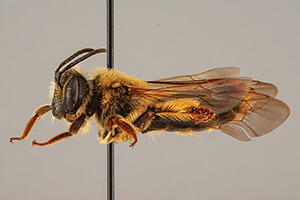
Decorah, Iowa, August 15, 2022 — Of the 55 species of bees found living on the Luther College campus this summer, seven have never been recorded in Iowa.
Emmelyn Cullen ’24 and Gwen Coleman ’24 spent the summer surveying bee diversity at Luther. “The objective of the research is to make recommendations so that we can encourage more of these native pollinators on campus,” said Cullen.
Kirk Larsen, biology professor and faculty advisor for this research project, highlights the importance of preserving and protecting the bee population. “They are really important to us as pollinators for our crops and our food. One-third of all the food that we eat involves a pollinator of some sort and most of those are bees,” he said.
The study is ongoing, but so far 55 species of bees have been found living on campus, including species new to Iowa.
“We have seven species that we are confident are state records, meaning they have not been previously found in Iowa and there are no specimens of these species collected from Iowa in any natural history collections that we know of,” said Larsen.
The seven new species to Iowa include:
- Megachile relativa which is normally found in Minnesota, Wisconsin, Illinois and Canada.
- Paranthidium jugatorium was spotted just north of Dahl Centennial Union. This species is widespread in the U.S. but not in Iowa.
- Heriades carinata which is commonly referred to as the giant resin bee. It is typically found in Minnesota and Canada.
- Stelis labiata is a parasitic leafcutter bee that lays its eggs in the nests of other species of bees. It is usually found in Minnesota, Wisconsin and Illinois.
- Andrena pruni, also known as the cherry miner bee, is previously known to live in Nebraska, Illinois and Minnesota.
- Ptilothrix bombiformis, the hibiscus turret bee, looks very much like a bumble bee. It is widespread across the southeast U.S. north and west to Missouri and Illinois, but this is the farthest northwest ever recorded.
- Heriades leavitti, a type of mason bee. It has been recorded in Nebraska, Minnesota, Wisconsin and Illinois but never in Iowa.
The identification of these new species indicates that Luther’s shift to planting more native flowers is working to attract pollinators. As part of their research, Cullen and Coleman record which plants attract which bee species in order to make recommendations to the grounds crew to ensure that bees continue to find necessary resources to thrive on campus.
Coleman summed up her experience by saying, “I never thought that I’d be doing an entomology project but I’m very happy that I got to take part and I’ve learned so much over the course of the summer.”
These findings came about through Luther’s Summer Student/Faculty Collaborative Research program which provides opportunities for students to engage in collaborative research projects with Luther faculty members. It is a chance for students to …


